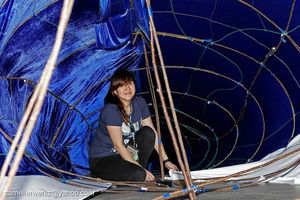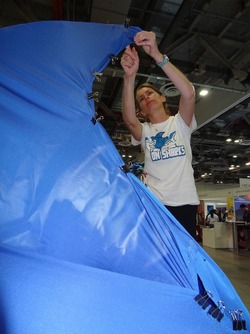Whale sharks... whale or shark - just what are they? Fiona Childs finds a unique way to tell others about these gentle beasts by making a whopper of a structure for display at ADEX 2013. She tells Gaia Discovery of her experience in this artistic journey.
Singapore, 28 April 2013. Sharks are anything but man-eating monsters. This image is far from the truth; in reality, it is humans that have pushed many species of shark to the brink of extinction for their hunger for fins.

Even live whale sharks do not eat humans.
Challenging this negative bias is an important step in inspiring people to care for these amazing and fascinating creatures that play a vital role in marine ecosystems. And although the largest, the whale shark, tops most divers’ ‘must see’ lists they are sadly listed by IUCN as vulnerable to extinction.
ADEX 2013 (Asia Dive Expo) was dedicated to whale sharks. Although these beautiful animals have recently gained protection in some areas, they are a migratory species of sharks that continue to be killed for their fins and meat. They also get entangled in fishing nets, which ends in a senseless and wasteful drowning.

Life inside a whale shark can be pretty extraordinary.
A number of conservation organisations have stepped up to the task of protecting these creatures. The ECOOCEAN project, for example, is attempting to expand our knowledge of the species by setting up a visual database of whale shark encounters and of individually catalogued whale sharks. The library is maintained and used by marine biologists to collect and analyse whale shark encounter data to learn more about these amazing creatures. Shark Savers is another organisation that seeks to promote shark conservation by way of public education and campaigns (including pledges to say "We're finished with fins") in addition to advocating shark sanctuaries and strengthening regulations. Shark Savers also makes effective use of art to send a clear signal against shark finning, such as this whale shark structure.
Art for Sharks
On behalf of Shark Savers Singapore, I proposed making a life size sculpture for ADEX 2013 expo to help raise awareness of the plight of sharks and rays. Having participated in building Biorock coral restoration structures and admired Celia Gregory’s underwater art, I was inspired by the artistic potential for ‘overwater’ sculptures using a similar technique.
Art is a way of transcending language. It is a powerful medium to inspire, move and engage viewers and artists alike. Collaboration is a key element; by contributing, people have an emotional investment and connection. For World Oceans Day 2011 in Bali, Celia and I built a bamboo manta ray with primary school students of Dyatmika School near Sanur. The children were proud of their achievement, awed by the size of the manta ray and motivated to learn more about them. As such, I knew a whale shark sculpture could have the same effect.
Every whale shark is unique, and this kid adds to its special "star patterns" that are used in researching this species.
Logistics meant that the 9 metre long sculpture had to be built in-situ, and I must admit I was nervous about how it would turn out. The day before ADEX opened, a team of volunteers from Shark Savers Singapore assembled to construct the framework using branches and fencing wire. To my relief, by the end of the first night we had something resembling a whale shark!
On the first day of the expo, the structure was already getting a lot of attention as we covered it with fabric. On day two, visitors were flocking to participate by painting spots and entering a naming competition. Over the three days of the expo, countless people stopped by to take photographs with ‘Smurfy’, as he was called. He got lots of attention, aroused plenty of interest and opened opportunities for discussion between volunteers and visitors.
We were able to explain basic facts, for example, that whale sharks are the largest fish in the world; they are filter feeders that eat plankton and although they have about 3,000 teeth, those teeth are tiny and useless! People came away from the show with the knowledge that whale sharks are gentle giants that pose no danger to humans; on the contrary, they need protection from us. We can read about their immense size, but unless you’ve been lucky enough to see one, it’s hard to imagine. I hope that the ADEX project helps correct a lot of those misconceptions – and helps preserve these wonderful creatures.

Fiona Childs and a team of volunteers build a life size whale shark at ADEX 2013.
STAR FACTS
- The ECOCEAN marine photo ID monitoring system uses software developed by NASA for identifying star patterns. This has inspired the proposed use of ‘constellation’ as the name for a group of whale sharks.
- In Madagascar whale sharks are known as ‘Marokintana’, meaning ‘many stars’.
- In recognition of his role in raising awareness, Smurfy won the ADEX Whale Conservation Award and became one of the stars of the show.
The writer is a conservationist, teacher and community artist. She volunteers with Shark Savers Singapore.
Shark Savers Singapore (SSSG) is part of non-profit Shark Savers, dedicated to saving sharks through building awareness, education, and grassroots action. SSSG launched their 'I'm Finished with Fins" campaign at ADEX 2012, featuring over 50 local personalities as supporters. Through raising awareness, SSSG educates people to make the informed personal decision to say no to shark fin soup and empowers them to stand by their convictions. The outreach team visits schools and educational institutions to give presentations. Many companies have since taken the corporate pledge to say 'We're finished with fins' and the campaign is now taking off in Hong Kong and Taiwan, the two other main hubs for shark fin trading and consumption. This year, as well as building a 9m whale shark, SSSG launched 'SharksCount' in Asia, a citizen science project to gather vital data about shark populations and a new Shark Awareness SDI/TDI course. www.sharksavers.org
Celia Gregory, founder of The Marine Foundation Eco arts organisation:
www.themarinefoundation.org
ECOCEAN:
http://whaleshark.org
Photos by: Joseph Tan@Cameller's Blog, Leon Lim@Hei Productions and Mallika Naguran@Gaia Discovery.
